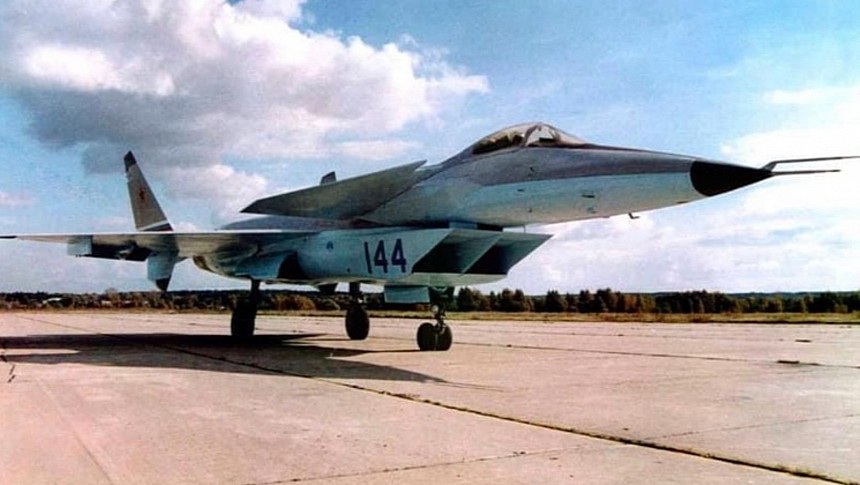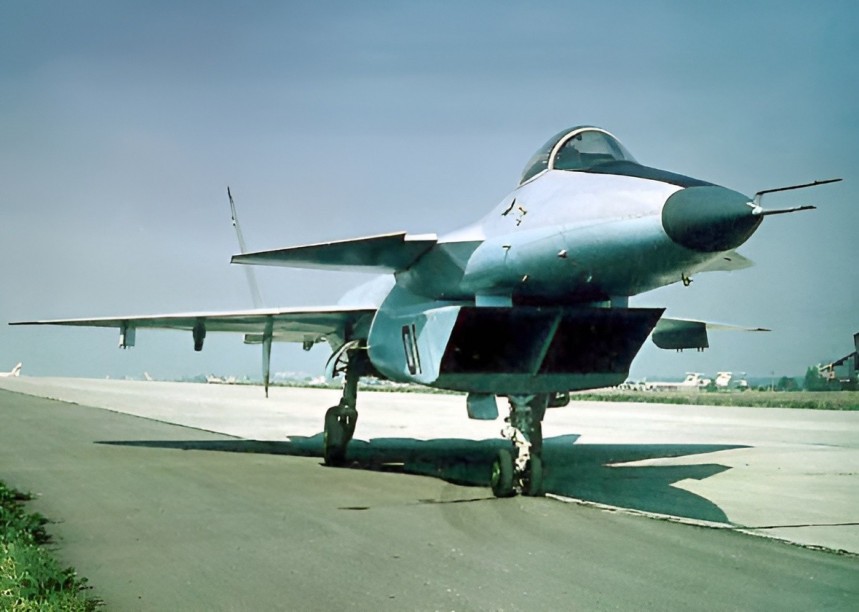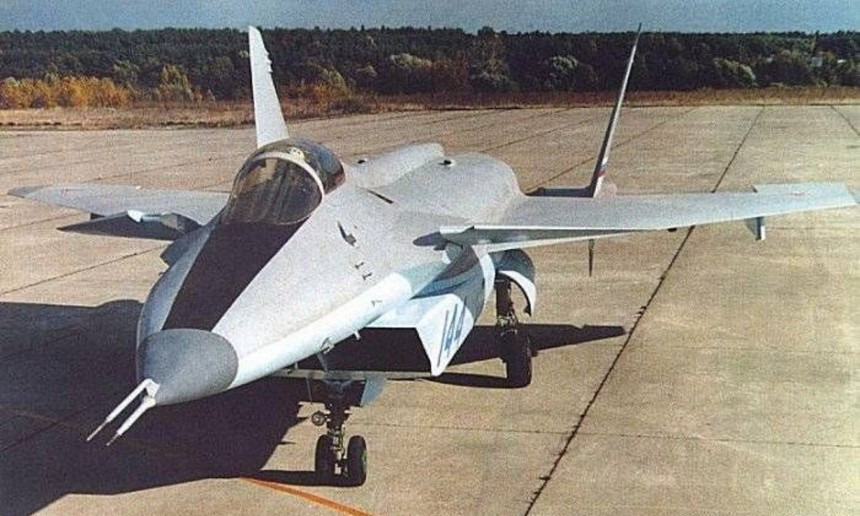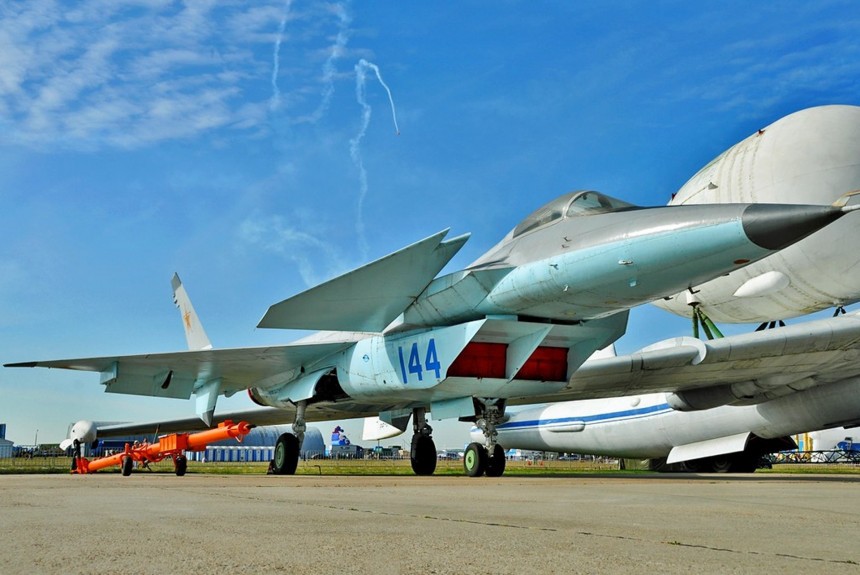Is there anything more time-honored in military aviation circles than poking fun at post-Soviet Russian jet fighters? It's like as soon as the hammer and sickle flag descended from the Kremlin, never to be seen again, Russia lost the ability to build a decent fighter in any significant numbers. But what if the Iron Curtain never fell? Well, in that case, Russia might be fielding two 2000s-baby jet fighters instead of just one. This is the story of the Mikoyan Project 1.44, the Russian gen-4.5-5-ish jet fighter that never was.
Allow us to paint the picture for you. It's the early-to-mid 1980s in Moscow during the period commonly dubbed the Era of Soviet Stagnation. The communist super-state's stoic, slightly scary-looking leader Leonid Brezhnev has just kicked the bucket. In his place, a succession of back-to-back crusty old CCCP bureaucrats named Andropov and Chernenko are shoehorned into leadership positions in their twilight years. That was until a certain port-wine birthmarked man with a penchant for that decadent capitalist delicacy known as Pizza Hut, Mikhail Gorbachev, swooped in to close out the Soviet era with Glasnost and Perestroika.
All the while, Soviet Air Force was struggling to keep up in a military arms race the which the 40th U.S. President, Ronald Reagan, intended to win by essentially performing an infinite money cheat code with the national defense budget. With that kind of financial backing under their wing, it made sense that the American fighter jets produced during this period were some of the finest ever built. From the swing-wing movie star F-14 Tomcat to the legit most successful jet fighter ever built in the F-15 Eagle, and the globally beloved-jack-of-all-trades F-16 Fighting Falcon, the Soviets had their hands full designing jet fighters that even reached parity with these all-time American greats.
But worse yet for state-run Soviet aerospace bureaus, things were about to get even more difficult. Between 1982 and 1983, Soviet espionage revealed the U.S. Air Force was already developing a fighter designed to even kick the snot out of F-14s and F-15s with its abilities. Though they didn't know the specifics yet, what Soviet intel was looking at was the U.S. Air Force's Advanced Tactical Fighter (ATF) program. The demonstration program intended to test the two contenders for America's first-ever stealthy jet fighter title, the Northrop YF-23, and the Lockheed YF-22. Against that kind of advanced hardware, the Soviet high command knew they needed to produce a countermeasure.
Safe to say, Kremlin orders are not merely friendly suggestions. The Soviet high command demanded that at least one aircraft be selected to contend against the tentative winner of the ATF program before the 1980s were finished. Dubbed Project I-90, with the Soviets probably not knowing they'd named the program after the longest U.S. Interstate, one of the contractors obligated to submit proposals to replace the front-line Soviet fighters was Mikoyan, known for their MiG line of fighters. Unlike the Americans, who'd already agreed that radar stealth was the lynchpin trait of all future jet fighters, the Soviets were running around like headless chickens, unsure of what an Eastern Bloc gen-V jet fighter would look like.
Key areas where both jets aimed to improve from past Soviet fighters included longer supersonic range endurance. Tales of Soviet pilots practically soiling themselves in fear after only flying supersonic for short intervals in MiG-21s still permeate av-geek circles to this day. To compete with American jets, Mikoyan's new twin fighters needed to be considerably more sturdy. It also needed to be affordable enough to not bankrupt everything east of the Iron Curtain to manufacture. So important was this aspect of Project I-90 that it was integrated into the 11th out of 12 of the USSR's five-year economic plans and the last before Perestroika.
With Mikoyan's decades of experience building MiG fighters, their response to the Kremlin's orders was to essentially throw cupcakes at the wall and see what stuck by designing two bespoke aircraft. One aimed at the heavy twin-engine, multi-role strike jet market a la the F-15E Strike Eagle, dubbed the MFI, and one geared towards countering smaller, more agile jets like the Eurofighter and the F-16 Fighting Falcon, christened the LFI. In doing so, Mikoyan aimed for a large degree of component parity between the two designs, making for a cheaper production process in an increasingly stagnating Soviet economy.
As it turns out, spending money on designing two separate airframes isn't as effective at cutting costs as dedicating to one design. In the end, Mikoyan chose to focus solely on the MFI and modify it into what was named Project 1.42. In this stage of the fighter's development, innovative design cues like an internal weapons bay instead of underwing pylons were considered. This cue would go on to become a trademark feature of all future stealth jets. But without the benefit of hindsight, Mikoyan opted against an internal bomb bay in the ultimate agreed-upon design. Focusing instead on raw maneuverability, not radar stealth, being the common denominator for future Russian fighters.
In its ultimately-approved pre-production form, the Mikoyan Project 1.44 was a bizarre-looking aircraft. At just over 71 feet long with a wingspan of 55 feet and nine inches (17 m), what we'll refer to as the MiG 1.44 from now on bares a striking resemblance to another famous jet fighter under development around the same time, the pan-European Eurofighter Typhoon. Indeed, the chin-mounted, variable-geometry air intakes and prominent canards jutting from underneath the fuselage in the MiG 1.44 was also key selling points for the British Aerospace EAP tech demonstrator, the direct ancestor of all modern Eurofighters. It's even said that China's first stealth jet, the Chengdu J-20, borrows heavily from the duck-like silhouette of the MiG 1.44.
Under the proverbial hood of the MiG 1.44 sat a pair of turbofans just as novel as the plane itself was. Two NPO Saturn AL-41 variable-cycle afterburning turbofan engines jetting 40,000 lbf (176 kN) of thrust each at takeoff. Interestingly, these engines theoretically outperformed the General Electric YF-120 and Pratt & Whitney YF-119 turbofans trialed on the YF-22 and YF-23. Doing so by between five and then thousand lbs of thrust, depending on which prototype is in question. This works out to a theoretical top speed of 1,540 mph (2,480 kph, Mach 2.35) in this 37,000 kg (81,571 lb) fully loaded jet. Slightly faster than both U.S. ATF prototypes.
The single MiG 1.44 prototype produced was designed to fly up to 1.5 times the speed of sound without the use of the afterburner, an ability referred to in the west as supercruise, with a service ceiling of 56,000 ft (17,000 m). For armament, the MiG 1.44 boasted a theoretically-impressive arsenal of R.77 semi-active, air-to-air missiles, R-73 short-range heat-seeking missiles, and R-37 long-range hypersonic air-to-air missiles, all from the Vympel NPO design bureau. If all else failed, a single Gryazev-Shipunov GSh-30-1 autocannon could take care of targets up close.
In theory, this level of ordnance paralleled the AIM-7 Sparrows, AIM-9 Sidewinders, AIM-120 AMRAAMs, and M60 20mm rotary cannon employed by the Advanced Tactical Fighter program. Even the MiG's N014 Pulse-Doppler passive electronically scanned array (PESA ) radar was impressive by early-90s standards, albeit not as powerful as the active electronic scanning array (AESA) radars found on production-spec F-22 Raptors. At least on paper, it looked as if Mikoyan had a potent jet fighter on their hands, even if its stealth capability was very much in question. Had everything gone to plan, the Soviets hoped to have their new fighter flying before the end of the 2000s at the very latest, if not far sooner.
Of course, it's pretty hard to flight-test a fifth-gen fighter when your entire government is collapsing like a stack of Matryoshka dolls around you. The complete collapse of the Soviet Union and the Warsaw Pact as a whole by 1991 had all but imploded the funding stream meant to get the MiG 1.44 in the air. For six long years, Mikoyan carried on with a shoestring budget, slowly assembling the sole test article the company could manufacture. Ultimately, the administration of the Russian Federation's first President, Boris Yeltsin, ordered the MiG 1.44 program canceled, sighting unforeseen costs and time overruns as the main contributing factors.
Even so, Mikoyan was permitted to complete the single prototype, doing so in January 1999. After as strenuous a development as there ever was in the 90s, the world's only MiG 1.44 took to the skies for the first time on February 29th, 2000, and then again two months later on April 27th. After a combined flight time of around 40 just minutes, the MiG 1.44s flight characteristics and the responsiveness of the fly-by-wire controls were reported to work well. But the MiG 1.44 never flew again, Likely because, by this stage, Mikoyan's rival design team at Sukhoi had already built the forward-swept-wing Su-47 Berkut, the technological inspiration for the PAK-FA, what ultimately became Russia's first operational stealth jet, the Su-57 (NATO codename: Felon), in 2010.
The sole MiG 1.44 was only seen a handful of times again after the year 2000, the last being at the International Aviation and Space Show (MAKS) at Zukhosvsly International Airport in 2015 before supposedly being put in storage at the Gromov Flight Research Institute in Zhukovsky, Russia. Putting an anti-climactic end to a tale that could have only begun in Soviet Russia. If not for the Invasion of Ukraine, which the MiG 1.44 would've undoubtedly been deployed in had it entered production, we'd almost call it tragic.
All the while, Soviet Air Force was struggling to keep up in a military arms race the which the 40th U.S. President, Ronald Reagan, intended to win by essentially performing an infinite money cheat code with the national defense budget. With that kind of financial backing under their wing, it made sense that the American fighter jets produced during this period were some of the finest ever built. From the swing-wing movie star F-14 Tomcat to the legit most successful jet fighter ever built in the F-15 Eagle, and the globally beloved-jack-of-all-trades F-16 Fighting Falcon, the Soviets had their hands full designing jet fighters that even reached parity with these all-time American greats.
But worse yet for state-run Soviet aerospace bureaus, things were about to get even more difficult. Between 1982 and 1983, Soviet espionage revealed the U.S. Air Force was already developing a fighter designed to even kick the snot out of F-14s and F-15s with its abilities. Though they didn't know the specifics yet, what Soviet intel was looking at was the U.S. Air Force's Advanced Tactical Fighter (ATF) program. The demonstration program intended to test the two contenders for America's first-ever stealthy jet fighter title, the Northrop YF-23, and the Lockheed YF-22. Against that kind of advanced hardware, the Soviet high command knew they needed to produce a countermeasure.
Safe to say, Kremlin orders are not merely friendly suggestions. The Soviet high command demanded that at least one aircraft be selected to contend against the tentative winner of the ATF program before the 1980s were finished. Dubbed Project I-90, with the Soviets probably not knowing they'd named the program after the longest U.S. Interstate, one of the contractors obligated to submit proposals to replace the front-line Soviet fighters was Mikoyan, known for their MiG line of fighters. Unlike the Americans, who'd already agreed that radar stealth was the lynchpin trait of all future jet fighters, the Soviets were running around like headless chickens, unsure of what an Eastern Bloc gen-V jet fighter would look like.
With Mikoyan's decades of experience building MiG fighters, their response to the Kremlin's orders was to essentially throw cupcakes at the wall and see what stuck by designing two bespoke aircraft. One aimed at the heavy twin-engine, multi-role strike jet market a la the F-15E Strike Eagle, dubbed the MFI, and one geared towards countering smaller, more agile jets like the Eurofighter and the F-16 Fighting Falcon, christened the LFI. In doing so, Mikoyan aimed for a large degree of component parity between the two designs, making for a cheaper production process in an increasingly stagnating Soviet economy.
As it turns out, spending money on designing two separate airframes isn't as effective at cutting costs as dedicating to one design. In the end, Mikoyan chose to focus solely on the MFI and modify it into what was named Project 1.42. In this stage of the fighter's development, innovative design cues like an internal weapons bay instead of underwing pylons were considered. This cue would go on to become a trademark feature of all future stealth jets. But without the benefit of hindsight, Mikoyan opted against an internal bomb bay in the ultimate agreed-upon design. Focusing instead on raw maneuverability, not radar stealth, being the common denominator for future Russian fighters.
In its ultimately-approved pre-production form, the Mikoyan Project 1.44 was a bizarre-looking aircraft. At just over 71 feet long with a wingspan of 55 feet and nine inches (17 m), what we'll refer to as the MiG 1.44 from now on bares a striking resemblance to another famous jet fighter under development around the same time, the pan-European Eurofighter Typhoon. Indeed, the chin-mounted, variable-geometry air intakes and prominent canards jutting from underneath the fuselage in the MiG 1.44 was also key selling points for the British Aerospace EAP tech demonstrator, the direct ancestor of all modern Eurofighters. It's even said that China's first stealth jet, the Chengdu J-20, borrows heavily from the duck-like silhouette of the MiG 1.44.
The single MiG 1.44 prototype produced was designed to fly up to 1.5 times the speed of sound without the use of the afterburner, an ability referred to in the west as supercruise, with a service ceiling of 56,000 ft (17,000 m). For armament, the MiG 1.44 boasted a theoretically-impressive arsenal of R.77 semi-active, air-to-air missiles, R-73 short-range heat-seeking missiles, and R-37 long-range hypersonic air-to-air missiles, all from the Vympel NPO design bureau. If all else failed, a single Gryazev-Shipunov GSh-30-1 autocannon could take care of targets up close.
In theory, this level of ordnance paralleled the AIM-7 Sparrows, AIM-9 Sidewinders, AIM-120 AMRAAMs, and M60 20mm rotary cannon employed by the Advanced Tactical Fighter program. Even the MiG's N014 Pulse-Doppler passive electronically scanned array (PESA ) radar was impressive by early-90s standards, albeit not as powerful as the active electronic scanning array (AESA) radars found on production-spec F-22 Raptors. At least on paper, it looked as if Mikoyan had a potent jet fighter on their hands, even if its stealth capability was very much in question. Had everything gone to plan, the Soviets hoped to have their new fighter flying before the end of the 2000s at the very latest, if not far sooner.
Of course, it's pretty hard to flight-test a fifth-gen fighter when your entire government is collapsing like a stack of Matryoshka dolls around you. The complete collapse of the Soviet Union and the Warsaw Pact as a whole by 1991 had all but imploded the funding stream meant to get the MiG 1.44 in the air. For six long years, Mikoyan carried on with a shoestring budget, slowly assembling the sole test article the company could manufacture. Ultimately, the administration of the Russian Federation's first President, Boris Yeltsin, ordered the MiG 1.44 program canceled, sighting unforeseen costs and time overruns as the main contributing factors.
The sole MiG 1.44 was only seen a handful of times again after the year 2000, the last being at the International Aviation and Space Show (MAKS) at Zukhosvsly International Airport in 2015 before supposedly being put in storage at the Gromov Flight Research Institute in Zhukovsky, Russia. Putting an anti-climactic end to a tale that could have only begun in Soviet Russia. If not for the Invasion of Ukraine, which the MiG 1.44 would've undoubtedly been deployed in had it entered production, we'd almost call it tragic.














